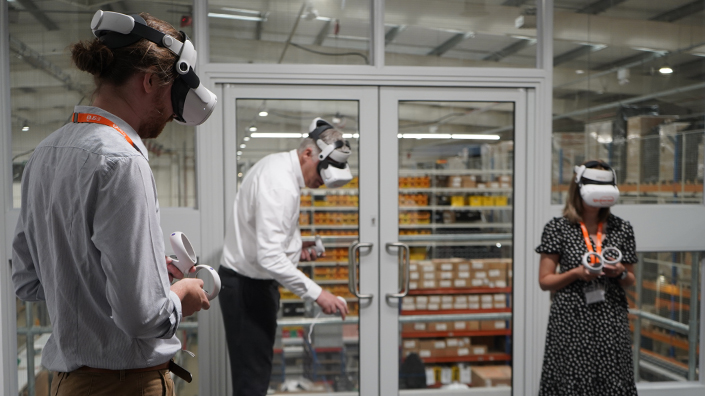That is the premise behind the ‘Iguverse’, a virtual reality (VR) experience created by high-performance plastics manufacturer Igus. Like a virtual version of a sample box, the VR showroom is used to demonstrate parts and systems for potential buyers.
The platform is streamlining the purchase and installation of products to prevent unexpected costs and help reduce carbon emissions, says Matthew Aldridge, director of Igus UK. It is already in use remotely and in-person – but it could look very different in future, as VR technology accelerates into the mainstream.
Into the Iguverse
One moment, I am standing in a plain, grey mezzanine room in the German multinational’s Northampton office and distribution centre. There is a square of blue tape surrounding me on the dark carpet below.
The next moment I am in the Iguverse, having pulled the VR goggles over my eyes. A partial human avatar across the virtual showroom is Aldridge, who talks me through the experience. The square of tape is replaced by a grid projected in my headset, warning me if I drift too far in the real world.

The author (left) explores the Iguverse with Aldridge (centre)
We are in the automotive room, one of more than 10 virtual environments focused on the different industries that Igus serves. Others include oil and gas, construction and machine tooling. A medical room has also recently opened.
Aldridge passes 3D models of parts back and forth, highlighting details in the smallest of bearings or mini-chains, which I can expand by simply stretching the product using my handheld controllers.
Navigating around the space, I stick my head through a car seat to see the complex parts beneath. I do the same in a moving pick-and-place delta robot, seeing how the internal systems interact.
In the loop
Back in the physical world, Aldridge sets out the company’s vision. The Iguverse is designed to provide practical, useful information, he says, showing customers how products will move and interact when installed in the real world.
“I can give you a delta robot, you can pick it up and look into it. To do that physically is heavy, it's hard work,” he says. A 3D model on a screen could give you a similar experience, he admits, but the immersive perspective can provide a deeper understanding of how a new machine could slot into a company’s workflow.
The platform “really comes into its own” when customers test integration of Igus products with their own facilities, says Aldridge. He gives the example of working with the operator of an offshore rig.
“We did a job with a system that we call an e-loop, which is a special kind of circular chain for guiding hydraulic hoses and cables on offshore rigs. And we were able to take the CAD of that offshore rig, put in the e-loop, and invite the customer into the Iguverse and show them how it fitted,” says Aldridge.
“When we showed them how it would work, they then made us aware of a part of the machine which was not in the CAD, but which they knew about, which would otherwise have fouled on the system. That would not have been picked up if we hadn't have gone through that 3D interactive experience.”
By preventing mistakes, the Iguverse could save customers time and money. Other benefits might include improved safety from virtual installation testing, and reduced carbon emissions from travelling to site visits or other physical testing.

Inspecting a vehicle inside the Iguverse
Digital future
Iguverse demonstrations are held for customers in Northampton, including in a large new room across the road from the company’s main offices. Sales engineers can also bring headsets to client visits or send them directly to customers, enabling remote meetings in the platform.
The company’s website is even more ambitious: “In the Iguverse, customers, engineers, project managers and decision-makers will come together in future as avatars in the digital space. They will carry out entire projects there, from the idea to the finished product – faster and more smoothly than is possible in the physical world alone.”
The platform is accessed using Meta’s Quest 2 goggles, but the pace of change in the VR and mixed reality market means the Iguverse could look different – on both the outside and the inside – in future.
Apple’s Vision Pro headset is due to launch in February, with a customary blend of high-tech hardware and slick user experience that could accelerate mixed reality uptake. The product’s 2023 launch video featured the Stages app from software and service firm PTC, which lets users review and approve new production lines in augmented reality. Other entrants to the scene include Siemens and Sony, who last week launched their vision for “immersive engineering” in the industrial metaverse.
“This technology is starting to be adopted by the big players in the game,” says Aldridge in Northampton. “Whether we will have the same style and design of headset in two years, five years’ time, I don't know. I doubt it.
“We're at the start of something here, a bit like CAD in the 1980s and early 1990s. Things were evolving very, very fast. I think we're at that point, really, with the whole virtual reality, Iguverse experience.”
Want the best engineering stories delivered straight to your inbox? The Professional Engineering newsletter gives you vital updates on the most cutting-edge engineering and exciting new job opportunities. To sign up, click here.
Content published by Professional Engineering does not necessarily represent the views of the Institution of Mechanical Engineers.